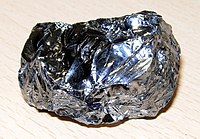
Photo from wikipedia
Abstract As one of the highest specific capacity anode materials in lithium-ion batteries, the main technical issue for silicon (Si) based electrodes is the rapid capacity fading caused by the… Click to show full abstract
Abstract As one of the highest specific capacity anode materials in lithium-ion batteries, the main technical issue for silicon (Si) based electrodes is the rapid capacity fading caused by the huge volume changes. Porous Si materials are reported to efficiently alleviate the side effects of volume fluctuation. However, the expensive precursor and complicated production process in previous reports limited their practical applications. Herein, we report a cost-efficient approach on the fabrication of porous Si via the low temperature aluminothermic reduction of low cost natural raw materials, combining the advantages of low temperature and natural materials. The porous structure of attapulgite-derived Si (SiATP) is well retained during the compositing process. The obtained composite electrode SiATP/graphite@carbon (SiATP/G@C) exhibits excellent electrochemical performance, with a reversible discharge capacity of 799 mAh g−1 after 100 cycles. To demonstrate the versatility of the approach, another natural ore, mica (MIC), was also utilized to the fabrication of porous Si (SiMIC). As expected, the SiMIC/graphite@carbon composite electrode also exhibits high specific capacity (697 mAh g−1 after 100 cycles), superior capacity retention (81% after 100 cycles based the 4th cycle), and outstanding rate capability.
Journal Title: Electrochimica Acta
Year Published: 2019
Link to full text (if available)
Share on Social Media: Sign Up to like & get
recommendations!